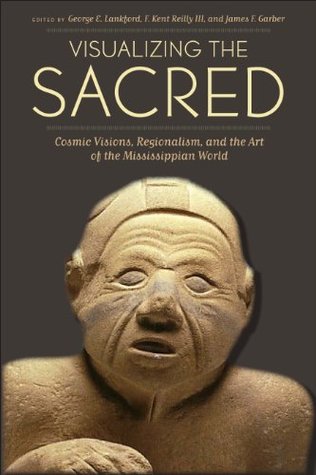Kindle Notes & Highlights
Read between
December 9 - December 22, 2020
present on the “shaman” figure at the Rocky Hollow site in...
This highlight has been truncated due to consecutive passage length restrictions.
Foot.
often portrayed in eastern Missouri in conjunction with SECC motifs.
However, it is conspicuously absent in the Waring a...
This highlight has been truncated due to consecutive passage length restrictions.
it is a regional variant;
The foot has been referred to in the ethnographic literature as representing brave warrior deeds
Pit and Groove.
so widely found in the rock-art record that it cannot be considered unique to Missouri or to the SECC.
it frequently appears along with SECC iconogr...
This highlight has been truncated due to consecutive passage length restrictions.
As a widespread motif (or element) it has been interpreted as either a phallic or vulva form and alternately as a possible celestial image.
Vulva Form.
this motif may be a regional variation in the SECC but is evident mainly at sites on the west side of the Mississippi River. This may signify the western/sunset/death connection to the “Old Woman” deity.
Circles/Concentric Circles.
most frequently portrayed geometric form in Missouri rock-art. It is represented as concentric circles, the cross-in-circle, the petaloid (or rayed) cross-in-concentric circles, the dot-in-circle, and circle chains.
Burns refers to the dot-in-circle motif as the Isolated or Sacred Earth
Cross-in-Circle and Spinning Cross-in-Circle.
present in materials from Cahokia, Spiro, Etowah, and Moundville,
The motif is not always a simple cross or a single circle but often a cross within a double concentric circle, rendering it more compelling and complex.
a reference to the “son of the Sun”—the avian representing the Hawk/son and the sun circle representing the Sun/father.
Mace.
common in eastern Missouri rock-art.
Whether they are cosmological signifiers (Douglass Gorget) or imperative to a triumphant warrior’s stance (Rogan Plate, Dancing Warrior, Black Warrior), they are remarkably uniform in appearance from eastern Missouri into northwestern Georgia (Etowah).
Bilobed Arrow.
At Maddin Creek the complex panel with the “Twins” and Giant portrays one of the twins with the bilobed arrow in his hair (Fig. 4.13c). The figure also sports a “ponytail” that could represent his red or blue “horn” or braid.
comparable to the “red horn/braid” on the “Resting Warrior” figure (pipe) from the Craig Mound at the Spiro site
Ogee.
wide distribution in the Eastern Woodlands
the transmigration between two cosmic levels.
In some examples, depictions of the ogee bring to mind a version of the vulva form and might serve as a metaphor for a portal.
Underwater Spirit.
Underwater Spirit (aka Cat Monster)
winged, horned serpent with the tripl...
This highlight has been truncated due to consecutive passage length restrictions.
two or more of these interacting motifs are used as a symbolic “shorthand” within the rock-art to imply a greater meaning than just the parts portrayed.
These repeated motif combinations unquestionably had symbolic significance during the Mississippian period and perhaps also earlier in the Woodland period.
It appears to be a mixing of Late Woodland, Middle Mississippian, and Oneota iconography in the Middle Mississippi Valley region.
believe that the material under examination has its origins in early Dhegihan culture,
There is a movement of SECC symbols (e.g., Birdman/Hawk Being, Piasas/Underwater Spirit, bilobed arrows, feet) from north to south and from east to west and west to east.
seems to begin a southward migration just before AD 1200.
As the possible epicenter of this collection of narratives and its accompanying iconography and artifact assemblages, I would single out the region surrounding the confluence of the Missouri and Mississippi Rivers, surely the most important prehistoric crossroads in North America.
Aside from regional stylistic variations within the iconography, many of these motifs that no doubt accompanied the oral traditions had great longevity.
manifestation of a pantheon of characters with a rich and lasting set of oral traditions—major narratives.
Over the years discussions of Mississippian iconographic art have focused on figural images portrayed in marine shell and copper. Since the earliest discussions of late prehistoric art, the Lower Mississippi Valley has been largely excluded from these dialogues despite the great wealth of ceramic art.
representational art forms such as engraved shell gorgets and cups, symbolic weaponry, and repoussé copper are only sporadically present in comparison to the great artistic centers such as Etowah, Moundville, and Spiro,
Second, the Lower Mississippi Valley’s surviving artwork is limited almost wholly to ceramic art forms, rather than the figural works in copper, flint, and marine shell.
Many of the most basic Mississippian religious motifs are emphasized repeatedly on ceramics, underscoring the use of pottery in rituals of life, death, and world renewal. A veritable explosion of ceramic art took place in the Eastern Woodlands in general, and the northern portion of the Lower Mississippi Valley (LMV) in particular, at the beginning of the thirteenth century AD.
The various ceramic forms include a number of decorative motifs and vessel shapes that changed over time, providing significant temporal markers and evidence of great artistic innovations and traditions. Yet a general conservatism existed in the basic artistic themes, furthering a long tradition in the use of ritually significant motifs in ceramic art.
Fineware vessels would have been interred with the ritual practitioners upon their death. Such an individual would be a member of a small privileged or elite family/lineage segment or sodality of a village or town.
ritual vessels would be limited in number and restricted to elite compounds and charnel house or ancestor shrine contexts.
fact, rather than being merely “decorated,” fineware ceramics represent a microcosm of the Mississippian world.
The northern portion of the Lower Mississippi Valley was one of the most densely occupied regions of the Eastern Woodlands during the Mississippian period.


